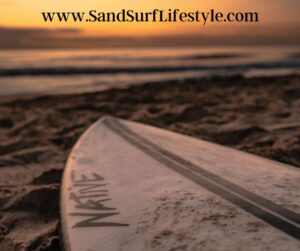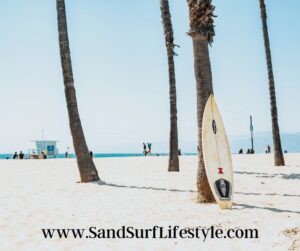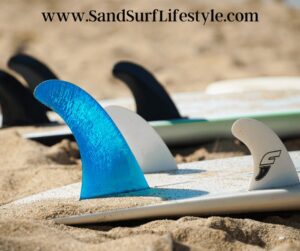Picking out what surfboard to buy requires a lot more research on what surfboard will fit your needs than the color and design of the surfboard. There are many different styles and constructions to surfboards. Surfboard rails are one important aspect to research before purchasing a new surfboard. Surfboard rails come in different shapes and styles. The rails on a surfboard are important because they change how the board rides in the waves. Some rails are also better for beginner surfers and some are better for performance surfers.
Parts of a Surfboard:
 A surfboard is made up of three parts which are referred to as the nose, rails, and tail.
A surfboard is made up of three parts which are referred to as the nose, rails, and tail.
The nose of the board is the top portion, the tail is the back of the surfboard, and the rails of the surfboard are the edges that run the whole length of the board.
Rails make up the shape of the board from the nose of the surfboard to the tail. The rails play an important role in how well the board will perform while surfing waves. This is because the rails impact how the surfboard will float in the water or how easy it will cut through the water and be able to maneuver in the waves.
Hard Rails V.S. Soft Rails:
The rails of a surfboard are broken down into hard rails or soft rails. The hard rails are sharper edges to the surfboard and have less padding on the edges. Soft rails have more padding to the edges of the surfboard so they are more rounded.
Soft Rails:
Soft rails do not have such a “sharp” curve to them and are more rounded and smooth on the edges. The soft edges allow for more foam on the sides which makes the surfboard float better on the water. The extra foam makes these surfboards lighter and why soft rails float better.
Soft rails surfboards are more rounded and have more padding to the edges. The rounded edges help so that they are more stable in the water.
However, that extra padding on the edges makes it so they are harder to turn and are not able to make sharp turns very well.
You will not go flying in the water as easily if you hit a wave wrong with a soft rail board as you would with a hard rail surfboard.
Soft rails make great surfboards and are most commonly found on longboard-styled surfboards.
Soft rail boards do not turn as well as hard rail boards, but they are more forgiving when you do hit a wave since they float better.
Since the soft rails surfboards are able to float in the water better they are also faster in water that has fewer waves in it. It is easier to paddle a soft rail board since they float on the water and are more stable.
Hard Rails:
 Hard rails are referred to as hard due to the “sharp” shape of the curve. Hard rails are best for making quick turns and swiftly moving through the water. Hard rail surfboards have sharper edges than soft rail surfboards. These sharp edges help the board cut through big waves better which is why they are easier to maneuver.
Hard rails are referred to as hard due to the “sharp” shape of the curve. Hard rails are best for making quick turns and swiftly moving through the water. Hard rail surfboards have sharper edges than soft rail surfboards. These sharp edges help the board cut through big waves better which is why they are easier to maneuver.
The sharp edges however are made by using less foam on the edges. This makes the surfboard not float as well as soft rail surfboards.
Hard rails are designed more for performance and are typically what you see the professionals use. They are not as stable and are much easier to tip over and lose control with. However, they can make sharp turns and glide through big waves which is something that soft rail surfboards can not do.
In calm ocean waters where there are not as many waves, hard rail boards do not move as quickly as a soft rail surfboard will. Hard rails are typically found in shortboards and are surfboards that are used for performance.
Do you know what a hybrid surfboard is? Find out all you need to know about them here.
Surfboard Folds:
The fold of the rail on a surfboard refers to where on the board the surfboard curves.
There are many variations to surfboard folds but there are three common types of rail folds. The three types of rail folds are:
- 50/50 fold
- 60/40 fold
- 80/20 fold
50/50 Fold:
The 50/50 folds are most common with soft rail boards.
Since 50/50 fold surfboards have an equal amount of board on both sides of them they float the best on the water.
60/40 Fold:
The 60/40 folds are found on both hard and soft rail boards. The 60/40 rails are best for smaller waves. They are typically easy to move around and are fairly stable in the water.
The 60/40 fold is the most versatile surfboard. They are considered to be intermediate surfboards and allow the surfer to get used to a more advanced board.
These are made so that they can turn better than a 50/50 fold, but they are still able to float on top of the water easier than 80/20 surfboards.
80/20 Fold:
The 80/20 folds are most commonly found with hard rail boards. The 80/20 folds are considered performance boards and are easy to turn and move around.
The 80/20 folds have sharp curves to them which is why they are able to turn so well in the water. However, they do not float as well and are harder to use especially for beginners. If starting out you may have some problems with this surfboard.
They are also harder to move and paddle in calmer water with fewer waves. In large waves, though, these are the boards that are able to move the best and you will have the most control of the board when going through these big waves.
Which Surfboard is Best For Me?
 Each surfboard comes with its own benefits and situations that they work best for.
Each surfboard comes with its own benefits and situations that they work best for.
For beginners, a soft surfboard with a 50/50 fold will work well since it is the easiest to float on. A soft 50/50 board would also work well if you are wanting to coast in the water instead of taking large waves. However, if you are wanting something to take large waves on then a soft 50/50 surfboard may not be for you.
A 60/40 board would be great if you are wanting to take on these big waves but still are new to surfing. These will float on top of the water better and will be easier to turn in large waves with. These also come in either soft or hard rails so if you want something that floats a little better a soft rail 60/40 surfboard may be for you.
If you are wanting to try out some new turns and are brave enough to start taking on some large waves then a hard rail 60/40 surfboard may be better for you.
The 80/20 boards are designed for those big waves and take a lot of turns. It is not recommended for beginners and is considered the best performance surfboard.
They do not float as well as other boards so if you are planning on paddling a lot in calm water with fewer waves then an 80/20 board may not be the best surfboard for that.
Time To Hit The Waves:
Surfing is a great way to spend a day at the ocean. However, there is a lot that goes into picking out the right surfboard for you. Picking out rail types whether hard rails or soft rails and where the folds are important aspects to consider when buying a surfboard.
Please note: This blog post is for educational purposes only and does not constitute legal or medical advice. Please consult a legal expert or medical professional to address your specific needs.

